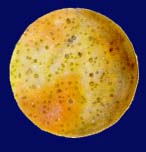Pluto
- Diameter is estimated at 1,600 miles (2,575 km).
- Distance from the Sun:
- Mean (average) distance is 3,666,100,000 miles (5,900,000,000 km).
- At perihelion (closest) 35,000,000 miles (56,327,000 km), which is closer than Neptune.
- Average temperature is -369°F (-223°C)
- Rotation takes 6.5 days (6 days, 9 hours, 17 minutes).
- Revolution takes 248 years, 182 days.
- Density is estimated to be about that of water.
- Orbit is in the shape of a flattened eclipse.
- Planet surface appears to be frozen methane.
- Most of the time, Pluto is the farthest planet form the Sun.
- At certain times, i.e. prior to 1999, Neptune's orbit was actually farthest from the Sun.
- Pluto has no atmosphere.
- Pluto has one known moon:
- Charon is named for a mythological Greek ferryman in Pluto's realm.
- Pluto has a lonely, estremely eccentric orbit.
- It is unlike all other planets except Mercury, which have orbits with little variation from the eccliptic.
- Pluto's orbit is at an angle of 17°10' to the ecliptic.
- The orbit is a very extended oval.
- Its eccentricity value is 0.246 (others mostly circular).
- At aphelion, Pluto is 4,600,000,000 miles (7,4000,000,000 km) from the Sun.
- At Perihelion, it is as close as 2,858,000,000 miles (4,600,000,000 km).
- during this portion or Pluto's orbit, is is inside of Neptune's orbit.
- This makes Neptune the farthest known planet for a time.
- Discovered on February 18, 1930.
- It first appeared as a dot on a photographic plate.
- Scientists had been searching for a 9th planet since the discovery of Neptune in 1846.
- Despite the systematic process which identified Pluto, more recent information indicates that Pluto cannot have been the planet researchers sought.
- Neptune had been discovered in the search for the cause of irregularities in the orbit of Uranus.
- More irregularities in the Uranus' orbit of could not be explained by the influence of Neptune.
- This renewed the search for another planet early in the twentieth century.
- Unless Pluto possessed an unheard-of density, higher than that of lead, it could not be responsible for affecting the orbits of gas giants like uranus and Neptune.
- Pluto has a density just over twice that of water.
- This indicates that it contains a rocky core.
- This center is probably overlaid with a mantle of frozen water and methane.
- The planet has a thin atmosphere.
- Surface pressure is less than one hundredth that of Earth.
- The atmosphere probably consists of methane in gaseous form, together with heavy gases such as nitrogen, argon, carbon monoxide, and ovygen.
- Surface temperature is around 58°K, or -355°F (-215°C).
- Like Uranus, Pluto is turned over in relatin to its oribtal plane.
- It pursues a far-ranging, centuries-long orbit with its spin axis tilted at an angle of 122°.
- In 1978, it was confirmed that Pluto was not super-dense.
- Photographic plates taken with a new telescope in Arizona revealed Pluto's image as elongated.
- The plates had been put aside because they were thought to be defective.
- Star images on the same plates were sharp.
- There could not be a fault in the machinery.
- Pluto's "elongation" revealed the presence of a large moon.
- The moon was christened "Charon," Pluto's ferryman in classical mythology.
- Charon's orbit is nearly 12,500 miles (20,000 km) from Pluto
- Revolution is once every 6.4 days.
- It was now possible to calculate the combined mass of Pluto and Charon.
- Together they were only a small fraction - about 1/500 - of the mass of Earth.
- There is no way that they could influence Uranus or Neptune.
- If Charon were seen from Pluto, it would seem to hang motionless in the same part of the sky all the time.
- The planet and moon are locked in aposition with the same face of each always opposed.
- They rotate around a mutual center of gravity.
- Charon has a diameter of 736 miles (1,186 km), more than half that of Pluto.
- It is the largest satellite, relative to the size of the planet it orbits, in the Solar System.
|




